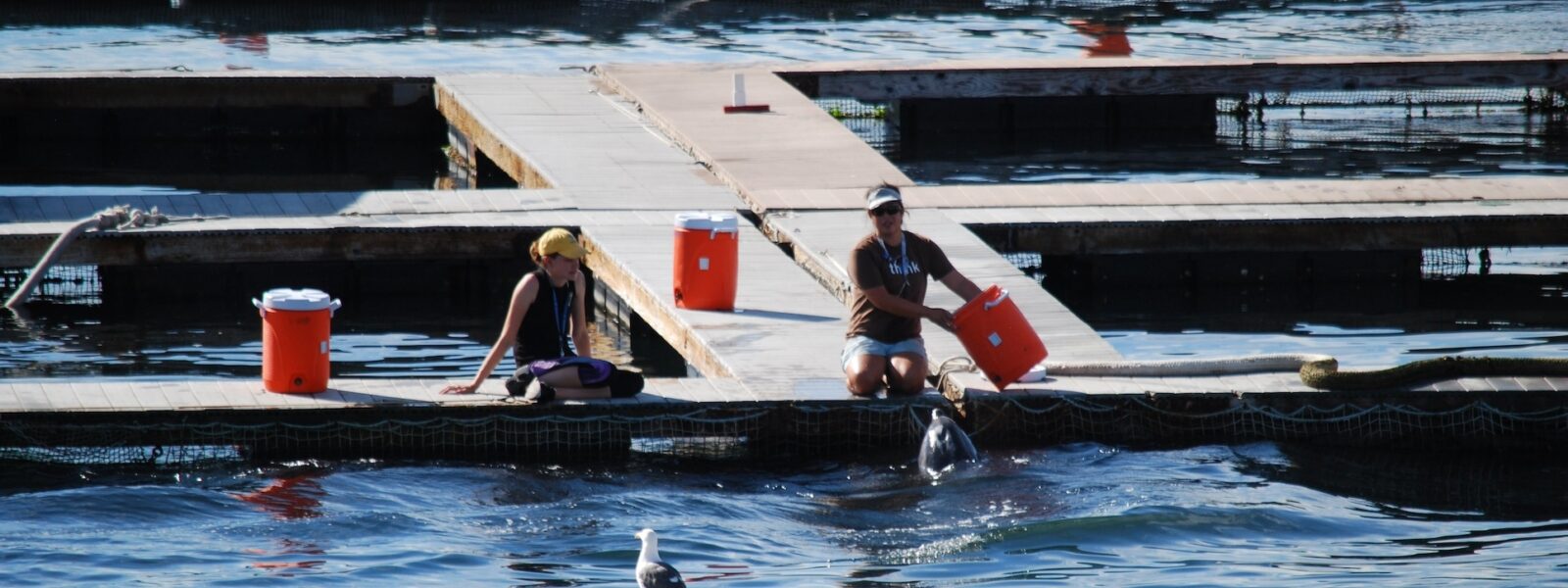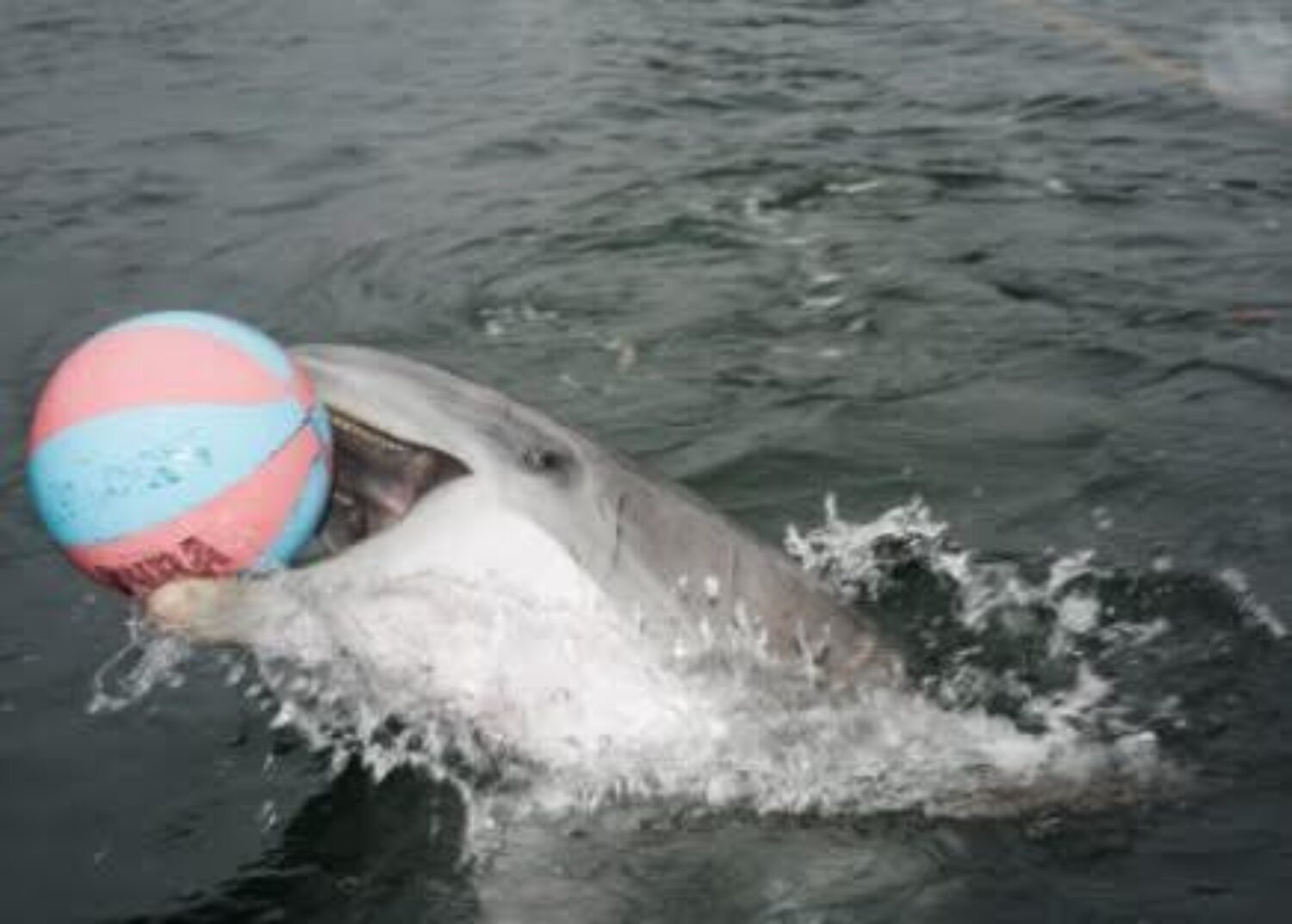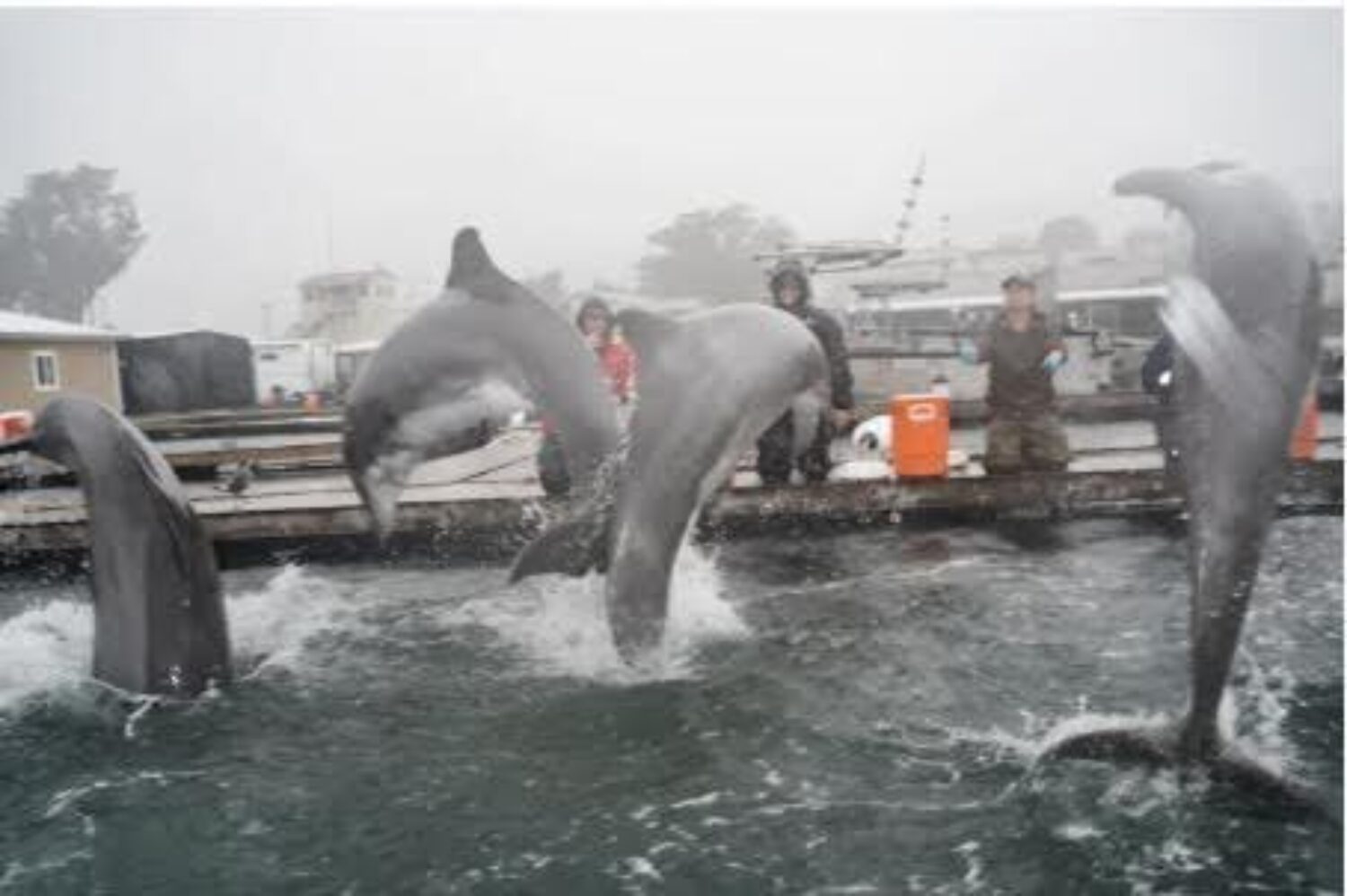
Should Dolphins Go to War for Us? Part 1
By Riley Freitas
The Ethical Dilemmas of the U.S. Navy’s Marine Mammal Program
Riley Freitas is an intern for the International Marine Mammal Project of Earth Island Institute. She is a graduate of the University of California with a Bachelor of Science in Conservation and Resource Studies. Within this major, she created her own area of interest: Marine Conservation and Policy.
The history of the U.S. Navy's Marine Mammal Program is a story as intriguing as it is elusive – a hidden world where dolphins and sea lions become unlikely heroes and victims in the service of national security.
Born during the cold war, after torpedoes proved to be too limiting, the Navy was inspired by the speed, agility, and cognitive skills they witnessed in dolphins. Not only did the hydrodynamic shape and speed influence improved torpedo and transportation design models, but the mammals’ ability to ride the bow waves in front of ships to further propel themselves and use their underwater sonar to detect objects underwater lead the military planners to consider their use as military animals.
The program was created to train dolphins, beluga whales, and sea lions to perform an assortment of underwater tasks, such as delivering equipment to divers underwater, locating and retrieving lost objects including lost bombs, guarding boats and submarines in port, defending against enemy swimmers, seeking and tagging underwater mines, and filming underwater surveillance.
During the 2003 Iraq War, the Navy sent two of their bottlenose dolphins, Makai and Tacoma, to help clear the way for ships carrying humanitarian aid (and likely munitions). The divers compared searching for the mines in the cloudy waters to crawling around in the mud with your eyes shut. Instead, they sent the dolphins to recognize the mine’s shapes, via their sonar which easily penetrated the murk, and return to the humans, grab a floatable marker, tow it back to the mine, and tag the mine as a danger zone.
But while these military cetaceans have displayed remarkable cognitive abilities and adaptability, their involvement in dangerous military operations raises serious concerns about their welfare and the moral implications of their use in warfare.
It is essential to recognize that these intelligent marine mammals do not have a choice in their participation. Lacking the autonomy to consent or refuse, these mammals are forced to fight our battles - they are exposed to potential dangers during their missions, including the risk of injury from mines, boats, equipment, loud noise like explosions, or even encounters with enemies, who will often kill any dolphin they encounter as a precaution to avoid US Navy dolphins.
Some may argue that the use of cetaceans in the field is similar to that of dogs, but dogs have spent more than 30,000 years being domesticated while dolphins are still very much wild animals. Humans are able to provide a socially rich world for dogs, as they can live in close quarters to humans, but it would be extremely difficult to create this same harmonious relationship for humans and marine mammals. Captivity, for example, has been shown to expose dolphins to stress, boredom, suppressed immune systems and often early deaths. These ethical concerns underscore the need for careful consideration and evaluation of the program’s impact on these animals’ welfare, raising questions about the moral implications of their involuntary involvement in military operations.
If we were to somehow push aside the fact that dolphins are coerced into these threatening circumstances and focus on how they are cared for, the issue would be just as pressing. Currently, the program has 77 dolphins and 47 sea lions, all kept isolated from one another in 9x9 meter ocean corrals in San Diego Bay, California. Wild cetaceans, known for their highly social nature, live in tightly-knit groups and establish enduring bonds and attachments. Chronic stress can arise from the absence of family members, a lack of social interaction with fellow dolphins, and exposure to circumstances beyond their control.
Although the navy will argue that the dolphins are released once a day to roam freely in the open ocean, they made sure to find a way that these dolphins will never be truly “free”. The late Russ Rector, a former dolphin trainer turned marine mammal freedom advocate, shared that while working with Ocean World in Florida, representatives from a government agency expressed interest in techniques to understand how dolphins can become addicted to substances to ensure their return to the base to get their fix.
The navy has now upgraded this system of keeping their once wild dolphins tamed with an Anti- Foraging Device (AFD). This device is actually just a strip of Velcro around the dolphin’s stouts to prevent them from catching food, eating, or hydrating, so when they return to the base, trainers will remove the restricting Velcro and reward them with food.
Closing these cetaceans off from the rest of their world and training them with a food dependency sounds more and more similar to amusement parks that train animals to perform for the audience, but why does the Navy fly under the radar more than, say, SeaWorld? The photos below depict the Navy program’s “enrichment sessions” for their dolphins, where they are directed by trainers to perform leaps, curls, and ball skills. Like performing dolphins and seals in aquariums, the animals are kept hungry during the day in order to ensure they will do the tasks set for them by their Navy overseers.


Military dolphins are treated much like trained dolphins in aquariums -- playing with balls substitutes for the stimulation wild dolphins would get interacting with their pods and swimming to find food.
Back in 1992, Congress directed the navy to spend $500,000 to develop procedures on how to release the dolphins back into the wild. The Navy concluded that there were so few dolphins suitable for release that it would be financially smarter to keep them with the program for the rest of their lives. In fact, in the early 1990s the navy gave up three of their dolphins to a private facility in Florida which then released them, but the release was botched. One dolphin reappeared begging boaters for fish and the other two were found dead from starvation.
As the dolphins and sea lions age, health problems arise that the Navy’s team of veterinarians and scientists must address. One dolphin, Makai, aged 46, was deployed during the 2003 Iraq War to locate mines in the Persian Gulf, an endeavor that would prove detrimental to his well-being. As he fell sick and became unable to swim, the decision was made to place him in a full-body flotation device. This act raises ethical concerns about the potential harm inflicted. A few months later, another dolphin was also documented wearing the same specialized outfit, suggesting an ongoing practice. Both dolphins were subjected to invasive procedures such as tube feeding, IV fluids, and blood sampling, actions that can be viewed by many as ethically questionable and harmful in the context of scientific research on these marine animals.
The Navy’s treatment of and research on dolphins is full of ethical concerns that demand immediate attention and action. Under the disguise of scientific exploration, these highly intelligent beings are subjected to chillingly cold waters to determine the lowest temperatures they can withstand during Navy deployments, intravenous saltwater administration to see how they react, and invasive procedures to unlock information about human diseases, such as diabetes. Locked in test tanks, they have no escape from these harsh conditions, causing distress and discomfort that challenged the very core of ethical research.
Michele Bollo, an animal welfare activist who has done extensive research on the U.S. Navy’s Marine Mammal Project adds, “The Navy's rhetoric dismisses the number of dolphins that have been repetitively used in testing that compromises health and puts them at risk. This is not speculation. The controversy over the treatment of the dolphins and the nature of Navy mission is clear by virtue of the Navy’s very own Marine Mammal Inventory Report (MMIR). Cause of death for hundreds of dolphins on the MMIR is not representative of wild populations. Attempts to correlate with human conditions like diabetes are questionable. For instance, a captive-controlled population fed frozen fish is inevitably going to visit disease states and death unlike their wild counterparts, and such small sampling is no better than junk science.”
These sentient creatures should not bear the burden of potentially harmful and even lethal experiments aimed at human interest. The secrecy surrounding mysterious dolphin deaths and denied requests for necropsies only deepen suspicions about the true extent of harm endured in the name of research. It is our duty to advocate for the fair treatment of these marine mammals, demanding transparency, compassion, and responsible research practices in their regard.
Ideally, the dolphins and sea lions should be moved to seaside sanctuaries, where they would receive care for the rest of their lives, including food and veterinary care, in a much more spacious and healthy ocean home. In such a facility, experts could ascertain if any of the dolphins and sea lions are good candidates for release. Most would likely live out their lives in the sanctuary, but they would be able to live like dolphins and sea lions, not like regimented and hungry soldiers stuck in a permanent non-voluntary enlistment with the Navy.
These marine mammals should not be considered part of our military arsenal. A collective mindset shift is essential to agree that these animals deserve a bioethical status that is closer to our own.
*************************************
